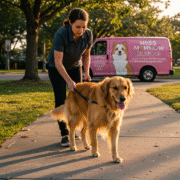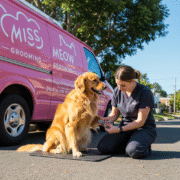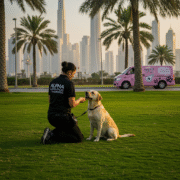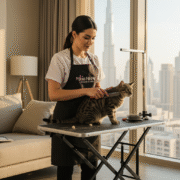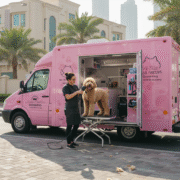Warning Signs Your Pet Needs Grooming Now
Introduction
Grooming is often perceived as a luxury for pets – a way to keep them looking tidy and smelling fresh. While aesthetic appeal is certainly a benefit, regular and professional grooming is fundamentally about maintaining your pet’s health, comfort, and overall well-being. Far from being just a cosmetic service, grooming involves crucial aspects like coat care, skin health assessment, nail trimming, ear cleaning, and checking for parasites or abnormalities. Neglecting these essential tasks can lead to a myriad of painful and potentially serious health issues for your beloved companion. Recognizing the signs that your pet is overdue for grooming is vital. These signs are not just inconveniences; they are often clear indicators that your pet is experiencing discomfort or is at risk of developing complications. Paying attention to these warning signals allows you to address their needs promptly, preventing minor issues from escalating and ensuring your pet remains happy and healthy. Ignoring these signs can lead to painful matting, skin infections, mobility problems, and even behavioral changes due to discomfort.
Warning Signs Your Pet Needs Grooming Now
Understanding the subtle and not-so-subtle cues your pet gives you is key to proactive care. Here are some critical warning signs that indicate your furry friend is in urgent need of a grooming session:
1. Severe Matting and Tangling: This is perhaps the most obvious sign. Mats are tightly tangled clumps of fur that can form close to the skin. They occur when shedding hair gets caught in the surrounding coat, especially in breeds with longer or curly hair. Mats are not just unsightly; they are incredibly painful. They pull on the skin, restrict movement, and can hide underlying skin infections, parasites, or wounds. Severe matting can cut off circulation and even cause hematomas when aggressively removed. Brushing at home can help prevent minor tangles, but established mats often require professional attention to be safely and painlessly removed without causing injury to the pet’s skin.
2. Unpleasant Odor: A healthy pet should not have a strong, offensive odor. While a slight “doggy” or “catty” smell is normal, a pervasive stench that lingers even after a quick wipe-down is a red flag. This odor can be caused by buildup of oils and dirt in the coat, yeast or bacterial infections on the skin, or issues with the anal glands. Regular bathing during grooming helps remove dirt and excess oils, while a professional groomer can also check for skin issues and address potential anal gland problems, which often require professional expression.
3. Excessive Shedding: While shedding is a natural process, a sudden increase or consistently excessive shedding might indicate that your pet’s coat is not being properly managed. Undercoats can become impacted, preventing new hair growth and causing discomfort. Professional deshedding treatments can significantly reduce shedding by removing loose undercoat hair effectively. This not only keeps your home cleaner but also promotes a healthier coat and skin for your pet.
4. Skin Irritations, Redness, or Flakiness: Parting your pet’s fur and examining their skin is crucial. Look for redness, rashes, bumps, sores, or excessive flakiness (dandruff). These can be signs of allergies, parasites (like fleas or mites), fungal infections, or underlying skin conditions exacerbated by poor grooming. Grooming provides an opportunity for the groomer to notice these issues during bathing and drying, alerting you to potential problems that need veterinary attention.
5. Dull or Greasy Coat: A healthy coat should have a certain luster and feel relatively clean. If your pet’s fur looks dull, dry, brittle, or excessively greasy, it’s a sign something is amiss. This could be due to lack of proper brushing to distribute natural oils, buildup of environmental pollutants, or even dietary deficiencies. Professional bathing and conditioning can restore the coat’s health and shine.
6. Overgrown or Broken Nails: Pet’s nails grow continuously and need regular trimming. Overgrown nails can cause pain and difficulty walking, leading to changes in gait that affect posture and joint health over time. In severe cases, nails can curl and grow into the paw pads, causing painful infections. Broken or split nails are also painful and can snag, leading to further injury. Clicking sounds on hard floors are a common indicator of long nails. Nail trimming is part of routine grooming and prevents these painful issues.
7. Excessive Ear Wax or Odor: Pet’s ears, especially those with floppy ears or hair growth inside the canal, can trap moisture and debris, leading to wax buildup and infections. A tell-tale sign is a foul odor emanating from the ears, redness inside the ear flap, or your pet scratching at their ears or shaking their head frequently. Gentle ear cleaning is a standard part of professional grooming and helps prevent painful ear infections.
8. Tear Stains or Eye Discharge: Some breeds are prone to tear staining, a reddish-brown discoloration around the eyes caused by porphyrins in tears. While not always indicative of a major issue, excessive staining can trap moisture and lead to skin irritation. More concerning is thick or discolored discharge from the eyes, which could signal an infection or other eye problem. Cleaning the eye area is part of grooming, but persistent discharge warrants a vet visit.
9. Discomfort or Pain When Touched: If your pet flinches, bites, or shows signs of pain when you try to brush them or touch certain areas, it could be due to mats pulling on the skin, underlying skin conditions, or joint pain exacerbated by tight fur or long nails. A professional groomer is trained to handle pets gently and can identify areas of discomfort, potentially uncovering issues you weren’t aware of.
10. Changes in Behavior: Pets in discomfort may exhibit behavioral changes. A typically active pet might become lethargic or irritable. Painful matting can make them reluctant to be touched or groomed. Long nails can make walking uncomfortable, reducing their desire for exercise. Recognizing these behavioral shifts can point to physical discomfort that grooming can help alleviate.
11. Dandruff and Dry Skin: Just like humans, pets can suffer from dry, flaky skin, especially in certain climates or seasons. Excessive dandruff can be uncomfortable and itchy. While sometimes caused by diet or environment, it can also be addressed through professional bathing with moisturizing shampoos and conditioners appropriate for pets.
12. Paw Pad Issues: The pads of your pet’s paws are tough but can still suffer from dryness, cracking, or cuts. Long fur between the pads can also cause discomfort, trap debris, and contribute to infections. Routine grooming includes checking and trimming the fur between the pads and moisturizing them if needed, promoting comfort and preventing injuries.
13. Scooting: When a dog drags its rear end across the floor, it’s often a sign of anal gland discomfort or impaction. While not directly a grooming issue, it’s often discovered or suspected during a grooming appointment, as anal gland expression is a service offered by many groomers. Addressing this discomfort improves the pet’s well-being.
If you observe any of these warning signs, it’s a strong indicator that your pet is due for professional grooming. Seeking out experienced groomers, such as those at Miss Meow Grooming, ensures that your pet receives comprehensive care tailored to their specific needs and breed requirements. Regular visits not only keep your pet looking their best but are a critical component of preventative health care, allowing issues to be identified and addressed before they become severe. Don’t wait for these signs to become extreme; incorporating professional grooming into your pet’s routine is an investment in their long-term health and happiness. You can easily book your pet’s grooming appointment and discuss any concerns with their skilled team. Providing consistent, quality care is key to a thriving pet.
Conclusion
Paying close attention to your pet’s physical condition and behavior is essential for their well-being. The warning signs discussed – from painful mats and skin irritations to overgrown nails and ear issues – are not merely cosmetic problems. They are indicators of potential discomfort, pain, and underlying health risks. Recognizing these signals early and acting promptly by scheduling a grooming session is a crucial responsibility of pet ownership. Regular professional grooming is a preventative measure that keeps your pet clean, comfortable, and healthy, often identifying potential health problems before they become serious. Think of it as a vital part of their health maintenance routine, just like vaccinations and vet check-ups. By staying vigilant and prioritizing your pet’s grooming needs, you contribute significantly to their quality of life, ensuring they can run, play, and snuggle without the hinderance of preventable issues. Don’t delay; if you notice any of these signs, it’s time to ensure your beloved companion receives the care they deserve. Explore professional pet grooming services today and make regular grooming a cornerstone of your pet care routine.

